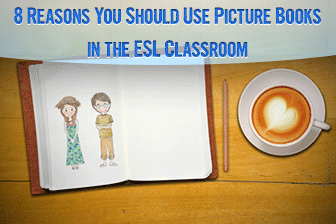When your main goal in teaching is showing students how to work with words and use them correctly, pictures may not seem like the most straightforward means to an end.
The truth is, however, that picture books are a great resource for language teachers, and your ESL students will gain many benefits when you use them in class. Here are 8 great reasons to think twice before cutting the pictures from language class!

Here's Why You Should Use Picture Books in Your Classroom
-
1
They Abate Anxiety
If your teacher handed you a 200 page book with no pictures written in a language you were just starting to learn, how would you feel? Traditional classroom texts can feel overwhelming for students just learning to speak and read English. Picture books are more welcoming, more manageable and less intimidating than all those black and white pages.
-
2
Activate Knowledge
One key to being a successful ESL teacher is getting your students to think about the topic at hand before you introduce new material. Bringing what your students already know to the foreground of their minds is essential for making connections with new material. Picture books will get your students thinking about what they already know about a topic, and they may bring up questions, assumptions and cultural values that your students hold about the topic at hand.
-
3
All Around Experience
Introducing new material, particularly content based material, can be difficult when your class may have very little experience with that topic. Picture books can be a resource for giving your students a common experience and background with a particular topic and creating a culture of knowledge in your classroom. Before introducing new content to your students, read to them several picture books that have to do with the subject at hand. Using different styles of literature (historical fiction, nonfiction, biography, etc.) with different types of illustrations will ensure a connection with every student in the class.
-
4
Accelerate Reading Comprehension
When language and vocabulary are a mountain ESL students must climb, picture books offer the tools they need to get to the top. By providing additional comprehension clues through pictures, your ESL students will be better able to decipher unfamiliar vocabulary and grammar. Pictures can bypass the word level barriers that your students struggle with and help them infer the meaning of unfamiliar language.
-
5
Literary Assists
If you teach literature in your class, you will likely touch on topics such as alliteration, simile, metaphor, irony, personification, satire and foreshadowing. For simple examples in isolation, picture books just might be the answer. You can find hundreds of examples (and more) of these literary elements in the great collection of picture books your library has to offer!
-
6
Admirable Writing
What writing skills will you address in your next writing class? Will it be sentence structure, mechanics, writing dialogue, expository writing, or writer’s voice? No matter what topic you have planned, picture books can serve as a model for that type of writing. Just because these books are short and contain colorful pictures does not mean that they have less value as writing models than chapter books. Pulling concisely written lines from engaging and entertaining picture books can be just what your students need to adopt the process in their own writing!
-
7
Abstracts Made Concrete
While much of what we ESL teachers teach is tangible, clothing and weather for example, not everything is so easy to picture, especially in a second language. Abstract concepts like emotions, attitudes and cultural values can be made concrete when they are communicated through a picture book. Your students will be able to see happiness, honesty and respect when you communicate it through a story and pictures.
-
8
The Amusement Factor
The simple fact is that picture books are fun! Whether they relate an amazing adventure or outline empirical data, your students will enjoy the material more when it comes from a picture book. Since they are so engaging and inviting, students will be amused by even the most straightforward information as they look at pictures which articulate those ideas.
You do not have to teach elementary ESL to appreciate the classroom value of picture books.
When chosen intentionally and with thought, picture books can be key to helping your students understand and connect with otherwise esoteric writing.
P.S. If you enjoyed this article, please help spread it by clicking one of those sharing buttons below. And if you are interested in more, you should follow our Facebook page where we share more about creative, non-boring ways to teach English.







